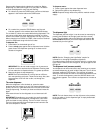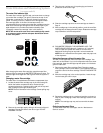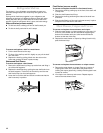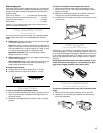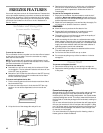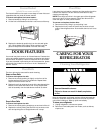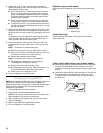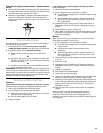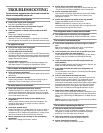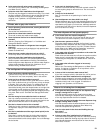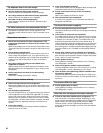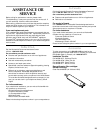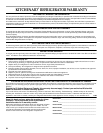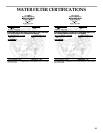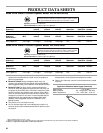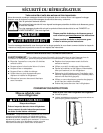
20
TROUBLESHOOTING
Try the solutions suggested here first in order to avoid the
cost of an unnecessary service call.
Your refrigerator will not operate
■
Is the power supply cord unplugged?
Plug into a grounded 3 prong outlet.
■
Has a household fuse or circuit breaker tripped?
Replace the fuse or reset the circuit.
■
Is the refrigerator or freezer control turned to the OFF
position?
Refer to the “Setting the Controls” section.
■
Is the refrigerator defrosting?
Recheck to see if the refrigerator is operating in 30 minutes.
Your refrigerator will regularly run an automatic defrost cycle.
The lights do not work
■
Is the power supply cord unplugged?
Plug into a grounded 3 prong outlet.
■
Is a light bulb loose in the socket?
Turn the refrigerator or freezer control to OFF. Disconnect the
refrigerator from the electrical supply. Gently remove the bulb
and reinsert. Then reconnect the refrigerator to the electrical
supply and reset the control.
■
Is a light bulb burned out?
Replace with an appliance bulb of the same wattage, size,
and shape. See the “Changing the Light Bulbs” section.
There is water in the defrost drain pan
■
Is the refrigerator defrosting?
The water will evaporate. It is normal for water to drip into the
defrost pan.
■
Is it more humid than normal?
Expect that the water in the defrost pan will take longer to
evaporate. This is normal when it is hot or humid.
The motor seems to run too much
■
Is the room temperature hotter than normal?
Expect the motor to run longer under warm conditions. At
normal room temperatures, expect your motor to run about
40% to 80% of the time. Under warmer conditions, expect it
to run even more of the time.
■
Has a large amount of food just been added to the
refrigerator?
Adding a large amount of food warms the refrigerator. It is
normal for the motor to run longer in order to cool the
refrigerator back down.
■
Is the door opened often?
Expect the motor to run longer when this occurs. In order to
conserve energy, try to get everything you need out of the
refrigerator at once, keep food organized so it is easy to find,
and close the door as soon as the food is removed.
■
Are the controls not set correctly for the surrounding
conditions?
Refer to the “Setting the Controls” section.
■
Are the doors not closed completely?
Push the doors firmly shut. If they will not shut all the way, see
“The doors will not close completely” later in this section.
■
Are the condenser coils dirty?
This prevents air transfer and makes the motor work harder.
Clean the condenser coils. Refer to the “Cleaning Your
Refrigerator” section.
■
Are the door gaskets not sealed all the way around?
Contact a qualified person or a technician.
NOTE:
If the problem is not due to any of the above,
remember that your new refrigerator will run longer than your
old one due to its high efficiency motor.
The refrigerator seems to make too much noise
■
The sounds may be normal for your refrigerator.
Refer to the “Understanding Sounds You May Hear” section.
The ice maker is not producing ice
■
Is the freezer temperature not cold enough to produce
ice?
Wait 24 hours after ice maker hook-up for ice production.
Refer to the “Setting the Controls” section.
■
Is the ice maker wire shut-off arm in the OFF (wire shut-
off arm up) position (on some models)?
Lower wire shut-off arm to the ON (wire shut-off arm down)
position. See the “Ice Maker and Storage Bin/Bucket”
section.
■ I
s the ice maker switch in the OFF (right) position (on
some models)?
Move ice maker switch to the ON (left) position. See the “Ice
Maker and Storage Bin/Bucket” section.
■
Is the water line shut-off valve to the refrigerator not
turned on?
Turn on the water valve. See the “Connecting the Refrigerator
to a Water Source” section.
■
Is an ice cube jammed in the ejector arm?
For models with an interior ice bin, remove the ice from the
ejector arm with a plastic utensil. For models with an ice
bucket, access the ice maker by depressing the ice bin
sensor door on the upper left side of the freezer interior. While
depressing the sensor door, lift the ice maker service door
and remove the ice from the ejector with a plastic utensil.
Refer to the “Ice Maker and Storage Bin/Bucket” section.
■
Does the ice maker mold have water in it?
Check to see if your refrigerator has been connected to your
home water supply and the supply shut-off valve is turned on.
Refer to the “Connecting the Refrigerator to a Water Source”
section.
NOTE:
If not due to any of the above, there may be a problem
with the water line. Call for service.
The ice maker is producing too little ice
■
Has the ice maker just been installed?
Wait 72 hours for full ice production to begin. Once your
refrigerator is cooled down, the ice maker should begin
producing 70 to 120 cubes every 24 hours.
■
Has a large amount of ice just been removed?
Allow 24 hours for ice maker to produce more ice.
■
Are the controls set correctly?
Refer to the “Setting the Controls” section.



